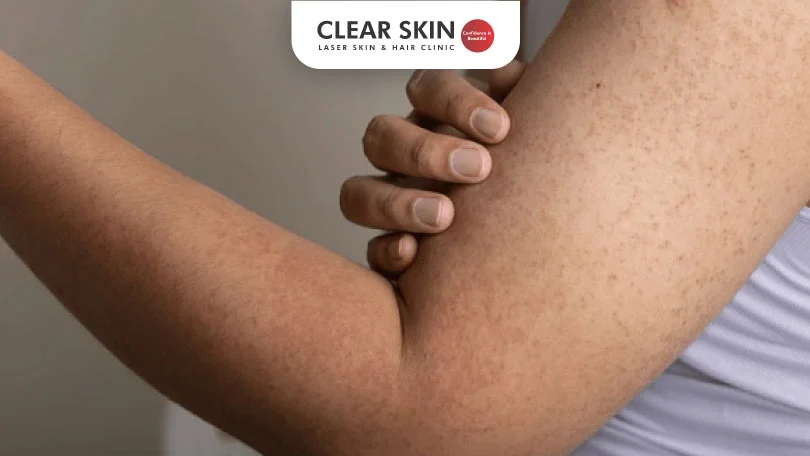How to Get Rid of Keratosis Pilaris?
Reviewed By: ![]() Dr. Dhanraj Chavan
Dr. Dhanraj Chavan
Updated on: 27th February, 2022

Keratosis pilaris is a skin condition characterized by rough patches and bumps on the skin. It is caused by excess generation of keratin which blocks the hair follicles, resulting in the development of bumps on the skin. When dead skin cells lock into the hair follicles, rough patches and bumps are formed on the skin. These bumps are red or white in color, and they are not painful or itchy. Keratosis pilaris is not contagious. This skin condition can worsen during the winters when the skin gets dry. It has no cure, but there are some treatment measures to ease the symptoms of keratosis pilaris and ways to prevent this condition. The condition improves with age, even without treatments, and whatever treatments are offered, are for cosmetological purposes. Here we will look at the keratosis pilaris causes, symptoms and treatments.
Table Of Content
- Keratosis Pilaris Causes
- Symptoms of Keratosis Pilaris
- Keratosis Pilaris Treatment
- Conclusion
Keratosis Pilaris Causes
- Keratin is a protein present in the skin, which is a major building block of the skin. A buildup of keratin caused by excess generation of this protein in the body, leads to blocking of the opening of hair follicles. This results in the formation of patches of rough skin.
- When dead skin cells plug into the skin pores, rough and dry patches may develop on the skin, aggravating keratosis pilaris.
- A skin condition like atopic dermatitis may cause keratosis pilaris.
- The exact cause of excess generation of keratin is not known, but the reason is thought to be genetic.
- Those with a family member with keratosis pilaris are more likely to get this condition. This condition is seen to run in families.
- Keratosis pilaris could be linked with vitamin A deficiency.
- Dryness of the skin worsens the condition.
- This skin condition is more common in childhood and teenage years and mostly improves in adulthood.
Symptoms of Keratosis Pilaris
- Small bumps can be seen on the upper arms, cheeks, and thighs. The bumps are painless, but may cause irritation of the skin.
- The skin in the regions of bumps, is dry and rough.
- The bumps can be described as similar to sand paper.
- Keratosis pilaris worsens when there is less humidity in the air and when the skin gets dry.
- The bumps on the skin look like goosebumps, are similar in color to your skin tone and appear like small pimples or a rash.
- Due to itching and irritation, redness and inflammation may be seen.
- Keratosis pilaris on black skin or brown or dark skin, is characterized by small pimple-like bumps and there may or may not be discoloration. On fair or light-colored skin, the bumps appear pinkish purple, red or white.
- Keratosis pilaris on arms appears as small bumps on the upper region of the arms.
- Keratosis pilaris on legs appears in the form of rough patches and bumps, mostly on the thighs.
- Those with keratosis pilaris on face, experience the symptoms mainly on the cheeks.
Keratosis Pilaris Treatment
- In order to reduce the symptoms of keratosis pilaris, it is advisable to avoid scratching the bumps and treat the affected skin gently. It is good to wear loose clothes so that friction from clothes is avoided. The skin should not be exposed to harsh chemicals and should be moisturized well.
- Creams with ingredients like retinoid, lactic acid, alpha-hydroxy acid and salicylic acid can help in soothing the symptoms of keratosis pilaris. These ingredients help in breaking down excess keratin and in removing dead skin. Consult a dermatologist to find out the best suitable treatment for you.
- Eczema is linked with allergies and those with eczema are more likely to get keratosis pilaris. So, it is advisable to avoid exposing the skin to allergens, so as to prevent the occurrence of keratosis pilaris.
- Since dry skin can worsen keratosis pilaris, it is best to avoid dryness of the skin.
- What foods should be avoided with keratosis pilaris? Although diet is not a cause of keratosis pilaris, intake of foods contributing to inflammation, may lead to or worsen the symptoms, so it is advisable to avoid foods causing inflammation.Those with keratosis pilaris should avoid the consumption of dairy products, soy, peanuts, trans fats, sugar and processed foods. It is good to follow an anti-inflammatory diet, which means, one should include fruits, lean proteins and healthy fats in the diet.
- So, keratosis pilaris treatment at home would include protecting the skin from dryess by frequent moisturizing, avoiding harsh chemicals/cleansers, using loose cotton clothes and dietary changes like avoiding inflammatory foods and increasing the intake of foods rich in vitamin A.
- However, if the symptoms of keratosis pilaris do not disappear after, changing your basic skincare routine or if other symptoms like infection, severe itching persist, it is necessary to seek medical advice.
- Your dermatologist will further guide you with the following treatment options which will help in reducing irritation and itching, and help with exfoliation.
- Treatment options are various chemical exfoliating agents, topical corticosteroid preparation of the correct potency according to the extent of the disease, and laser treatment.
- If the treatment measures are properly followed, keratosis pilaris goes away in 4-6 weeks. If you see your keratosis pilaris before and after pictures, you will notice a striking difference in the skin appearance.
Do You Know?
Roughly 250 Patients Are Treated
Everyday By These Dermatologists
(You are one click away from flawless skin)
Meet Our Dermatologist!
Conclusion
This article must have answered your questions like ‘what is keratosis pilaris?’, ‘what are its symptoms and causes’, and ‘what are the keratosis pilaris treatments?’ However, this content is for informational purposes only. If you or someone you know, is having keratosis pilaris on face, arms, legs, or anywhere else on the body, you should consult a dermatologist. He would diagnose your skin condition and administer an effective keratosis pilaris treatment that suits you best. Your online search for ‘keratosis pilaris best treatment’, would give you varied results, but it is important to select only the best facility and health care provider to get your skin condition treated. For expert advice on the causes, symptoms and treatments for keratosis pilaris, one of the best places to approach is ClearSkin. It is a skin clinic in Pune that has a team of experienced dermatologists who can give you reliable advice on a wide range of skin conditions and help you attain a healthy, beautiful and blemish-free skin.
Further Reading
No Results After Laser Hair Removal?
Explore expert advice on laser hair removal, its effectiveness, and aftercare. With tips from dermatologists.
Can Laser Hair Removal Damage Your Tattoo?
Curious about laser hair removal with tattoos? Learn how it works, explore alternatives, and get safety tips.
Understanding Laser Hair Removal: A Dermatologist’s Insight
Experience safe and effective laser hair removal with expert tips from dermatologists at Clear Skin pune. Schedule your consultation today!
Salicylic Acid: Your Ultimate Guide to Banishing Acne Scars
Discover how Clear Skin Pune can help you say goodbye to acne scars using Salicylic Acid.
Have thoughts? Please let us know
We are committed not only to treating you, but also educating you.






